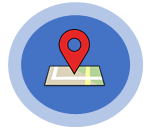Episode Two - O&M Scavenger Hunt
Introduction
Braille Bites Season Two – O&M Scavenger Hunt
A part of travelling safely to school is recognizing and understanding the various traffic and safety signs that are encountered on the route. In this O&M Scavenger Hunt, the learner searches for these signs in the community around their school. They can use tactile strategies by exploring the board using both touch and vision to locate and mark the signs they have found as well as the signs that they have yet to find.
Linked here is a PDF version of the O&M Scavenger Hunt recipe.
Key Ingredients
- A set of images of traffic and safety signs that are found in your community. You can take pictures of actual signs or search for images online. Print out these pictures/images.
- Poster board or cardboard for the base.
- Wax string (i.e., WikkiStix) or pipe cleaners.
- Clear plastic bump dots (often sold as cabinet door bumpers)
- Hot glue gun
Mixing It Together
- Selecting safety sign images/pictures. Be sure to select signs that the learner will encounter on their way to school, or in the community surrounding their school. You can include traffic signs (i.e., signage for drivers only) as well as safety signs (i.e., signage for drivers and pedestrians). It is important for your learner to understand how drivers are likely to behave given those signs. For example, your scavenger hunt board may include a yield sign since the learner will need to know that at that sign, drivers are more likely to be watching for what other vehicles are doing.
- Create the scavenger hunt board. Arrange the printed images/pictures on the cardboard base in a grid and use the hot glue gun to affix them to the board. A grid will make the images easier to scan during the scavenger hunt.
- Glue pipe cleaners or waxed string between the images to make a tactile grid.
- Go out and explore! You and the learner are going on a scavenger hunt to find the traffic and safety signs on the board. As you encounter a sign, use a bump dot to mark the sign that you have discovered. Be sure to stop and talk about each one, asking critical questions about each and discussing – What does it say? What colour is it? Where did we find it? What does it mean? Specifically:
- What does the sign tell drivers?
- What does the sign tell pedestrians?
- Encourage tactile strategies while playing. Regardless of the learner’s visual profile, try to encourage them to use their hands to explore the board to find the bump dots. If the learner can use their hands to scan the board, they can keep their vision focused on observing the environment around them.
Nutritional Information
Connections to the Expanded Core Curriculum
- Orientation and Mobility (O&M) refers to the knowledge, skills, and techniques associated with safer and more effective travel for blind and partially sighted learners and is an area of the Expanded Core Curriculum. This activity builds the learner’s O&M knowledge that they can apply when travelling in their community. Learning safety and traffic signs is critical to learning more independent travel in the community. The O&M Specialist is responsible for direct instruction in O&M but activities like this scavenger hunt are a great way to support this learning.
- Sensory Efficiency Skills. The learner will use their tactile exploration skills to explore the scavenger hunt board to explore for the bump dots indicating signs that have already been located. The learner may also use a low vision device, such as a monocular, to locate and identify signs that are farther away.
For More Information and Inspiration
- The Hunt is On! – Paths to Literacy. Set of great ideas for a scavenger hunt in a shopping mall – a more controlled travel environment without vehicle traffic.
- O&M Geometric Grocery Store Scavenger Hunt – Perkins School for the Blind. Activity idea for combining O&M, Independent Living Skills, and Math concepts at the grocery store.
- Road Safety Scavenger Hunt – Ottawa Safety Council. Check to see if your municipality has a safety sign scavenger hunt! This is an example from the Ottawa region.
Quicklinks

